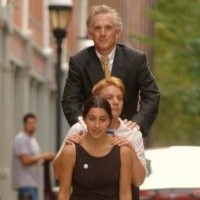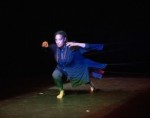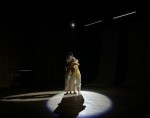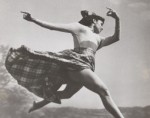
Silvana Cardell Teams Up with Blanka Zizka at Wilma Theater
by Jonathan Stein
Silvana Cardell has been creating and presenting solo and collaborative work in her native Argentina, the U.S., and internationally since 1990. She founded Cardell Dance Theater in Philadelphia in 2009 and serves as its artistic director. Her much acclaimed and riveting work on migrant refugees, Supper, People on the Move! premiered in 2015, launched a multi-city tour, and was recently reprised with new cast members at Drexel University. She has just opened the Cardell Dance Studio in the Fairmount area, while serving as director of the dance department at Georgian Court University.
In a new role, Cardell collaborates with Wilma Theater artistic director Blanka Zizka as a choreographer and movement consultant. Zizka, perhaps the most movement-savvy physical theater director in Philadelphia, has expressed a strong interest in the body and body memory. I spoke to Zizka over email prior to interviewing Cardell. She explained her unique work with the HotHouse group of Wilma actors, who “learn to listen to one’s bodies and the bodies of others; we make the text physical.” Cardell has contributed to four dramatic plays at the Wilma: ADAPT! (2017); Kill Move Paradise (2018); Romeo and Juliet (2019); and THERE (2019).
Jonathan Stein: Blanka is a theater person who loves dance, and I recall inviting her to join me to see your Supper premiere in 2015 and her being blown away by your work. How did things unfold after?
Silvana Cardell: I will always be so grateful to you for bringing Blanka to that opening night! We connected right away, in aspects of our journeys as immigrant artists, and artistically, we recognized shared interests in theatrical conceptual frames. As artistic directors, we were committed to creating in each performance unique environments and embodiments aligning physical and emotional aspects of movement and actions.
JS: Blanka has told me that in your dance theater your dancers’ bodies “are always connected to some very strong existential emotions,” and that, similar to a stage director, you “create a world that your dancers have to inhabit.” Do you see these as part of a shared aesthetic with the Wilma director?
SC: The world that performers inhabit in my work is essential for me because that is how and why I develop the movement score and choreography. Working with Blanka, I deepened my understanding of how the body responds physically to emotional states in relationship to the story in the script. In my own work, I exhaust my performers. I overextend the body to find states where the emotional and physical aspect of movements or actions coincides with the present moment. I believe that movement reaches its full expression when there is no representation of actions or emotions—whether it is to climb a wall with no gadgets to support you, or supporting your partner with one vertical pull—the performer needs full engagement, unconditional presence. For me, it is in these moments when narratives are embodied to the fullest.
JS: Had you worked in theater before?
SC: I briefly worked in theater and film in the past, but I quickly lost interest, first because in those productions dance and movement were not embedded in the theatrical discourse; it was rather decorative, imposed at the last moment. In Blanka’s rigorous and meticulous creative process, I recognized my own and I found new ways to make the body speak.
.jpg)
Photo: Johanna Austin
JS: Blanka has written me that she loves your “exploring the attempt to reach for the impossible, trying to make human bodies weightless yet recognizing the limitations of the body and the pull of gravity—a tension immensely exciting and absorbing.” I’m wondering whether you have been able to bring these qualities into any Wilma productions?
SC: I explore a turning point, a moment in between as if collapsing, suspending, or holding is what captures most purely the peak of an expression or an emotion. Working with actors not trained as dancers, I bring these impossible moments to life in gestures and actions that align within the performative score. The HotHouse actors are trained movers, they clearly understand how to reach these moments. In Blanka’s plays, the space where the characters interact is crucial, and that is, for me, the main point of entry into the work.
For example, in Kill Move Paradise, there was a steep slope, created by Matt Saunders, this huge white surface was very extreme and revealing, everything shown, nowhere to disguise. Actors’ entrances were often sudden and abrupt and I needed to choreograph sequences of movements to roll, slide, stand up effortlessly and securely as the slope was steep and risky. The actors needed to walk as if the tilted space was a “new normal” state of being; we worked on how to trace each part of the body to achieve a new alignment to regain the vertical pull in an unreasonable angled position, walking, sitting, running from that point of departure was very intense. Observing, experimenting, we adapted the bodies to the extreme space, and this influenced all aspects of the performance. It works both ways, the text and its meaning affected everything as well: space, bodies, actions, a new reality, a window into the world and state of being of the actors.
JS: How do the voices of the theater director and choreographer mesh in these situations?
SC: In Blanka’s plays my goal was to seamlessly work with movement scores in a way that the audience could not perceive the separation between choreographic sketches, scores, and the rest of the actions. I believe that is what Blanka is looking for, in each play that she invites me into, she melts the movement scores with text, visuals, sounds, all to serve the essence of the theatrical discourse. It is not improvisation, not choreography, but rather a way to direct movement scores creating the embodiment of states and ideas.
.jpg)
Photo: Alexander Iziliaev
JS: How do you address the challenges that the playwrights have not written in dance sections, and that the actors had developed the story and their roles in their rehearsal process?
SC: To start, I have several meetings with Blanka to understand her take on the playwright. Blanka explains how she envisions the moments where some formal dance is needed, like in Romeo and Juliet there is a party group dance and some fights that I did not choreograph but rather prepared the performers for; similarly, in ADAPT! when young and old Lenka danced together to a song, or when the pigs danced with the orgasmic lady. My work in the plays is not necessarily to create formal choreography but rather to develop movement needed throughout the play, offering a movement perspective in the world created. In ADAPT! and in Romeo and Juliet there were large props coming in and out of scenes and the actors needed to become invisible at times or exuberant in others, working with those actions and qualities is when the actors needed alignment and direction, further than staging. Looking for coherent gestures, actions that connect solely to the meaning of each play are essential in Blanka’s work and it is exactly what I seek in my own work.
I think my best contribution is to deepen how actors move through the entire performance, making sure the movement qualities have a distinct thread—the same brush as if the play was also a painting.
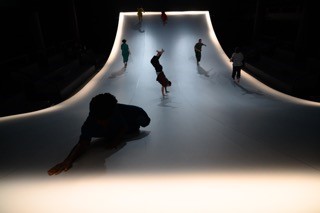
Photo: Johanna Austin
JS: Might you talk about your recent and perhaps most challenging collaboration, THERE, in the Light and the Darkness of the Self and of the Other, the Etel Adnan existential, book-length poem. A reviewer of THERE called your choreography “captivating.” As a poem, this work seemed like it might give you and Blanka substantial freedom. Adnan describes her poem as a “meditation on conflict.” Blanka adds that, for Adnan, poetry is a form of thinking; I assume you had to figure out how to stage this process of thinking, on the Rosa Barba-designed set of two steep slopes no less!
SC: THERE is like nothing I have done before. First, I was thrilled about the title, and then the huge white wave set created by visual artist Rosa Barba divided the audience. Blanka’s vision for the piece was inspiring. Hearing her talking about the existential questions that the play addresses created an illusion for me, as if the text had been written on the actors’ bodies.
The text, space, and creative process were unforgiving; we spent hours adapting the body to move on the waved floor, and with cables everywhere, darkness, and blinding projections, this was a harsh environment for the actors to embody these questions. Yet these extreme conditions brought the most profound responses from all of us. I believe the work came out as an insightful meditation on life.
JS: But staging/choreographing thoughts?
SC: This work was fascinating for me, the easiest to choreograph. Staging thoughts was delightful, I wanted to do it forever, I wanted to live there, on that stage listening to those thoughts all day!
Dance is a fleeting art, as is most of our thinking process, thoughts come and go, similar to how movements do not hold, because they are constantly morphing. Dance is a form of thinking for me, dance surprises me, very much as thoughts and poetic thinking surprise me. I am an improviser; my conscious and unconscious thinking processes lead my improvisation practice, as much as my thoughts lead my actions and precede my decisions.
JS: You say THERE was the easiest to choreograph, but it certainly looked immensely challenging from an audience perspective.
SC: In THERE, a non-narrative linear play, time was elapsed, reversed, sustained, propelled and this gave us the possibility to further play, finding seminal movement ideas that came from the text, evolving into actions and images. Ordinary thoughts mixed with heightened movements of awareness, creating landscapes where the body was suspended and the mind wondered, reverberating thoughts in the vast space. The challenge for me was how to portray the body in motion, stillness, or at rest in an alternative space, where gravity challenged every move, every step. The body weight was in constant conflict because defying gravity on an uneven surface is a struggle. It was captivating to choreograph the moments in between: ordinary walks, runs, and slides leaped into dance territory when actors connected their body mass negotiating with each shift of weight the mobility between their body parts. To achieve a smooth, neutral walk, the actors turned themselves on or off, becoming invisible when needed. The big wave set was a sculptural space that determined the way the actors could move, creating a dramatic and stimulating conflict with all the objects and bodies living in it.
The actor’s vision was also at stake at every moment; in that vast space with an audience all around them, where actors gazed was crucial to determine the thinking process. Being and breathing in the moment created vibrant presence and existence. The actors', musicians', and audience's visibility was another factor; everything showed. We had to choreograph every moment—dissipating, neutralizing the presence of the bodies at times to highlight the presence of the thought. Much as thoughts, movements could stay, dissipate or reverberate, in every moment the body and mind wrestled to be present. A memorable experience, an amazing quest.
JS: Does your experience with Blanka at the Wilma Theater offer insights for other choreographers who have not ventured into theater collaborations?
SC: I think it depends on the choreographer’s interest. My work is theatrical and physical; I have found a great match working at the Wilma with Blanka. I cannot work on projects that I am not greatly interested in; I do not take any of my projects as just “jobs,” they have to be my passion. Dance as a field has so much potential beyond the tricks and the set language and the competition; there is expression, compassion, support, engagement, and reciprocity that can only be felt in/with the body. I am in favor of collaborative processes; more choreographers and directors should open up to the possibility of working together to enhance each other’s reach.
JS: What’s coming up for you at the Wilma and beyond?
SC: To create choreography in Blanka’s work. I just love that she opens the space to her process for other artists. Creating is a very lonely task; it is fantastic to find connections like the one we have. Next, I would like to invite Blanka into my process to see how that interaction will be; I believe she is also a choreographer with amazing dramaturgic clarity! I would love to create a solo with her or to have her come to work with Cardell Dance Theater.
JS. And beyond the Wilma?
SC: I am working on Disposable Bodies, a performance that examines the treatment of bodies—both human and nonhuman—as disposable. The work questions: whose body is valuable, and whose body is not, and reflects my interest in creating dance developed within an interdisciplinary context and connected to current events. The work echoes my deep concerns about the precarious lives of oppressed humans and non-humans—the most vulnerable “others.” I am still looking for funding to fully create it and present this work.
JS: And might you offer a final word on your new studio, your very latest endeavor?
SC: I opened this studio to create a home for my artistic practice: to settle in one place, to create, explore, and interact with audiences, testing my work from sketches to final creations. As a choreographer, whose work is extremely physical, rigorous, and socially engaged, I also want to train dancers in my particular approach to movement.
At this moment, I also need to promote civic engagement through dance and significant themes that can create positive social change; having a place to gather artists and audiences is essential to my mission. This studio is right.
By Jonathan Stein
January 28, 2020

